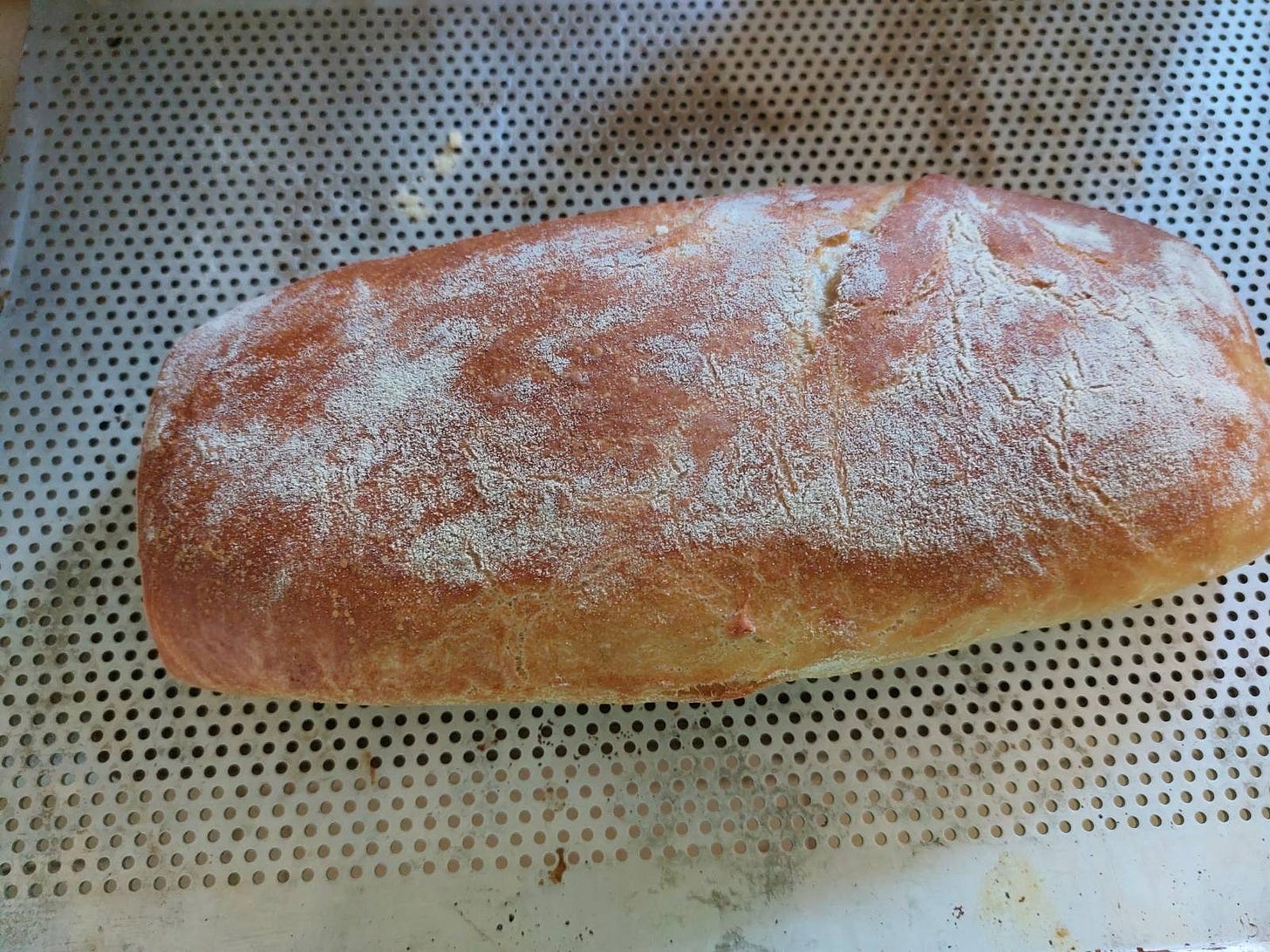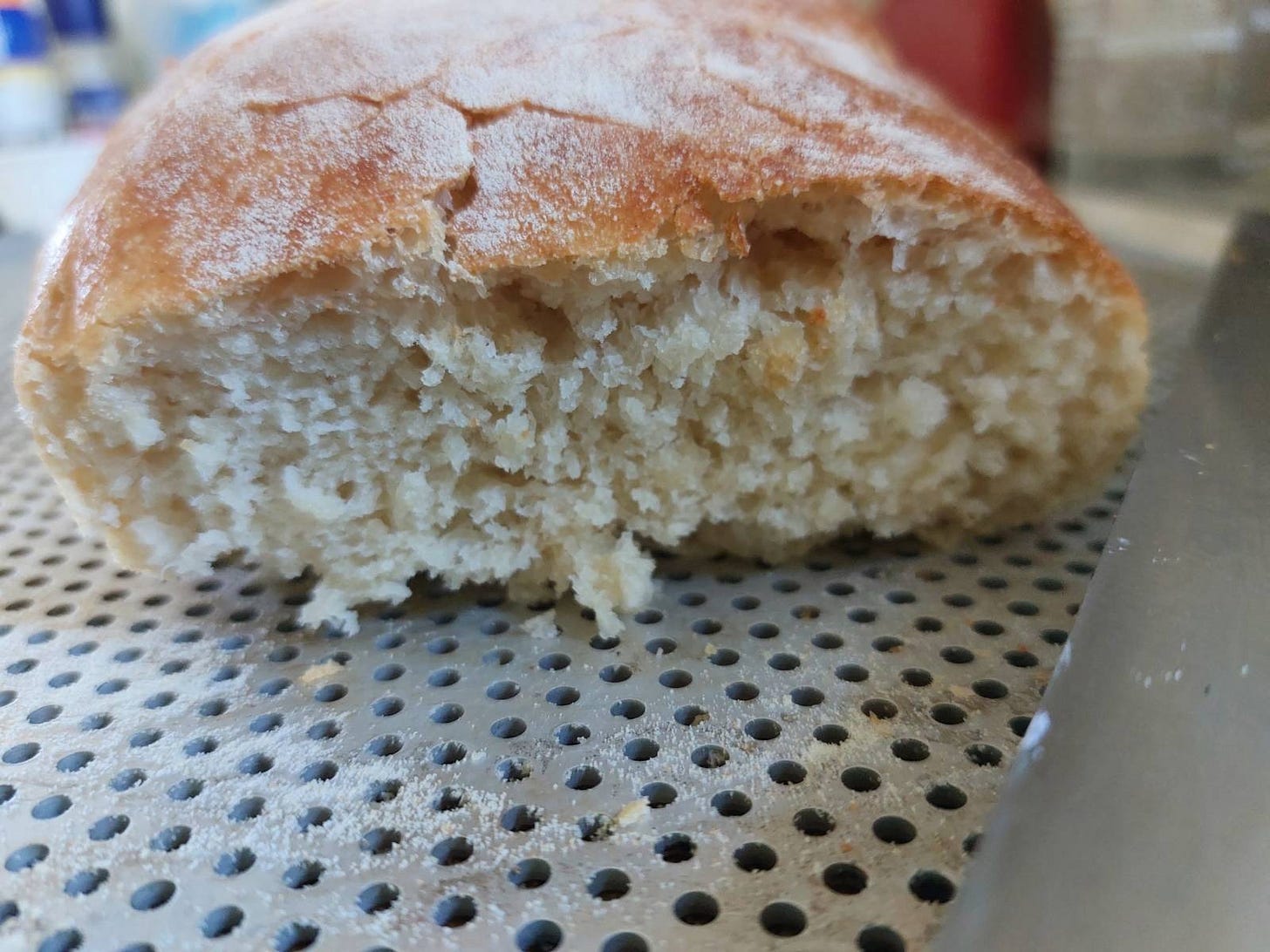I am not much of an optimist when it comes to searching recipes on the internet, especially for baking. My track record is not good, I’ve had my fair share of disastrous pancakes, and I am aware that my lack of experience in baking means I won’t have an easy time differentiating a good and a bad recipe. So when it comes to the search for one I will love I knew I had two options- trying dozens of recipes until I hit jackpot or making it up myself.
And of course, I chose the second option.
Making it up myself will require baking dozens of different breads anyway but will hopefully be a better experience as I will understand what I am doing and why.
Our pizza dough
The first thing I tried was based on the following pizza dough we make at home -
Ingredients
700 g Tipo 00 flour
300 g Tipo 1 flour
640 ml water
1 g of active dry yeast
Start by mixing the water and the yeast until the yeast dissolve. Then add the salt and mix until it dissolves.
Mix in the flour and knead until the dough reaches 25°C degrees or until you have enough gluten* (and over 22°C) , whichever comes first. If you had to stop and you don’t have enough gluten, leave the dough outside (covered in a moist towel) until enough gluten develops. You can give yourself more time if you use ice cold water and put the flour in the freezer in advance.
Now leave the dough outside for at least another hour. You can fold or slap the dough** every 20 minutes for better texture. When there is enough gluten* and an hour has passed put it in the refrigerator.
The next day, 2 or 3 hours before you want to have the pizza ready, you take the dough out and shape it into balls the size you want for the pizza and leave it outside at a few hours. The time depends on the temperature where you are, but we usually make sure it’s at room temperature for around half an hour before we start shaping and baking the pizza (at 400°C for a couple minutes).
About gluten, folding and slapping
* How to know you have enough gluten in your dough? Take a small piece of dough and stretch it with your hands. The dough should stick together and appear mostly transparent, like a window. If the dough breaks easily you don’t have enough gluten. But if the dough is very cold it will break easily regardless of gluten. This is called the gluten window test.
** What do I mean by fold and slap?
Fold-
Slap- making sure your hand is always wet, you start by picking up the sides of the dough and throwing back down 4 times. Then pick all of the dough and throw it back 6 times.
How we make peetas
660 ml water
70 g sugar
60 g olive oil
20 g salt
16 g dry yeast
1 kilogram of flour (can use regular flour or 100 gram of whole flour and 900 of regular flour)
Mix everything but the flour in a mixer. Add the flour gradually and continue kneading the dough. Again, we must not let it go over 25°C so if it’s hot outside use cold water and put the flour in the freezer a few hours before. Let is rest for one hour, covered in a damp towel. Fold and slap the dough. Another one hour rest. Fire up the outdoor oven and start making the dough balls with 100-120 gram per ball and roll each one. Flour it (very) lightly and put aside. When you finish dividing the dough start shaping. By the time you finish with the first four the oven should be around 300°C. Work with a lot of flour when you flatten the balls and put it in the oven until it is ready.
Hydration percent
The hydration percent is the weight of water (or liquid in general) you add to 100 grams of flour. 64 is a good percentage to work with at a start, as dough with 64 percent hydration is easy to work with.
Back to the search
So these are two recipes (with some details missing) that I know make very good bread, even though the baking will be different. I started with the simplest one.
First attempt
I made the pizza dough (amount divided by 3) and did everything as in the recipe for the first day.
The baking
The second day, I took the dough out one or two hours before I wanted to bake it. I preheated the oven to 250°C with a baking dish with hot water in it at the bottom for half an hour. Lightly oil the loaf pan or lightly dust the pan with semolina flour and put the dough gently in the loaf pan. Half an hour later I lowered the oven to 230°C degrees and put in the bread on a wire rack. After 10 minutes remove the baking pan with the water.
The bread is ready when it reaches inner temperature of 95°C. If after another 10 minutes it’s not ready lower the temperature to 200°C.
My thoughts
The bread is good, soft, but not as full of air as I wanted. I should probably have let it sit outside for longer. Very good in a toast, still denser than I wanted but it’s very good and as simple as I could hope for.
Now, let’s try something more complicated.
Second attempt
This time I used the following-
330 g of regular bread flour
10 g of lemon juice
20 g of olive oil
1 g of dry yeast
9 g of salt
9 g of sugar
190 ml of water
Mix everything but the flour in the mixer. Than do everything the same way (don’t let the dough go over 25°C, leave it outside until there is enough gluten, fold the dough the same way and so on). I let it sit outside for over 5 hours this time. Bake in the same way.
My thoughts
I definitely prefer to oil the pan with olive oil than to add semolina. I am not too fond of the texture of the dough that is placed on semolina, as it is less crunchy and strong. The bread was indeed lighter this time. I don’t think I can taste the lemon or the sugar in any way, and honestly it probably lacks some salt as I can’t taste it either.
This bread had less shape than the previous one, I think because of the very long second rise, 5 hours might be a bit much. A slice falls apart a bit if held weirdly.
It was also too soft to work as a toast, didn’t hold enough of a shape. My guess is that the long rising time is the reason, but I can’t be sure without a trying again.
This is it for this week when it comes to baking, as I have no access to a good kitchen until the next weekend. Hopefully I will have time to try a few things next week too.
Next time, I think I will try three main things. The first is higher hydration percentage. My guess it that to get the texture I am looking for I will need hydration percentage between 75 and 85. The second is to let the dough rise for an hour instead of 5 (and maybe add a tiny bit more salt). The third is to make the first attempt with a richer dough with butter, milk or cream.
See you next time!







